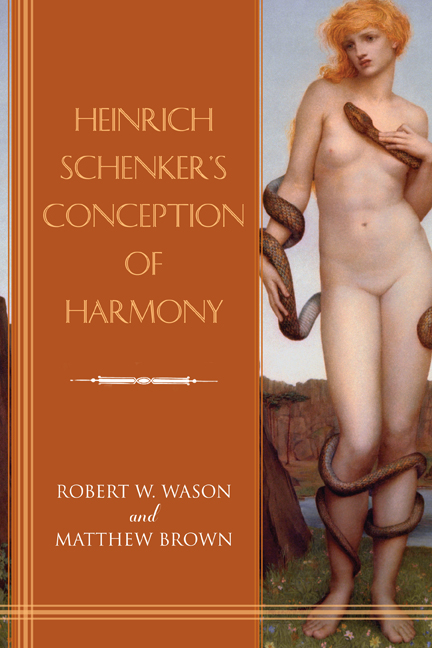1 - The Eclectic Intellectual Methodology of Schenker’s Theory of Harmony (1906)
Published online by Cambridge University Press: 14 October 2020
Summary
Introduction: Schenker's Reaction to the Classical Theory of Harmony
The original notion of “harmony”—the Classical idea—and the word denoting it, descend from “Harmonia” (Roman counterpart, “Concordia”), who, according to ancient Greek legend, was the illegitimate child of Aphrodite, the beautiful goddess of love and pleasure, and the handsome Ares, god of war and warriors. She was the progeny of this stormy “union of opposites,” and in that sense epitomizes this ancient idea: the element or elements that hold a complex system—such as a piece of tonal music, to place the notion in a modern context—together and make it work. She appears here in a wonderfully idealized rendering by the British painter, Evelyn De Morgan (1855–1919), the painting entitled Cadmus and Harmonia. According to one version of the legend, Cadmus, Harmonia's husband, was turned into a snake by Ares, though of course this pairing of the beautiful maiden with the snake surely suggested Eve in the Garden of Eden as well in nineteenth-century Britain. When De Morgan, some thirteen years Schenker's senior, painted this work (one of her earliest, done in 1877), she was associated with the later phase of the Pre-Raphaelite movement. In its synthesis of antiquity and modernity it was not unlike the later Viennese Jugendstil movement in the fine arts, crafts, and architecture that surrounded Schenker during the period he was contemplating his research in melody and writing his Harmonielehre. Nor is Schenker's book, in its approach to harmony, unlike this synthesis.
The word harmonia (΄αρμονια) was also present in the everyday language of ancient Greece. In common parlance, it came to mean a joining of things, such as the planks of a ship, or even the joint itself. By extension, the word could refer to a framework, thereby giving rise to its philosophical meaning of a framework for the universe itself. In a similar vein, harmonia was also used to refer to a social or political consensus (cf. Latin, concordia), a meaning well known to Schenker, the lawyer.
- Type
- Chapter
- Information
- Heinrich Schenker's Conception of Harmony , pp. 1 - 82Publisher: Boydell & BrewerPrint publication year: 2020



